
|
ChironomidsClass: Insecta
Order: Diptera
Family: Chironomidae 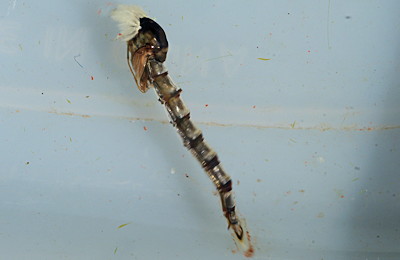 | | Chironomid Pupa |
Species of the Dipteran order have been buzzing around for over 200 million years. They have evolved into one of the largest and most diverse of all insect orders, with over 3500 species in North America alone. Literally translated Diptera means two (Di) winged (ptera) referring to the winged adult stage. Some of the better known members of this order include mosquitoes, crane flies, black flies and the common house fly. Diptera have a complete lifecycle or metamorphosis consisting of egg, larva, pupa and adult. From an aquatic perspective and a fly fisher’s interest the Chironomidae family is without a doubt the most important. Capable of incredibly dense populations chironomids or midges to some have more species than all other aquatic insects combined. For many anglers the chironomids often small size range, diminutive physique and technical presentation techniques are a source for distain. Make no mistake; chironomids are of critical importance. From personal study these insects often constitute over 50% of stillwater trout’s food intake in productive lakes. Trout consume so many of these insects, especially the larval or pupal stage, that they respond instinctively to a proper combination of presentation and pattern. If there is a hatch or not, trout can be taken consistently all season long on both moving and stillwaters with chironomids.
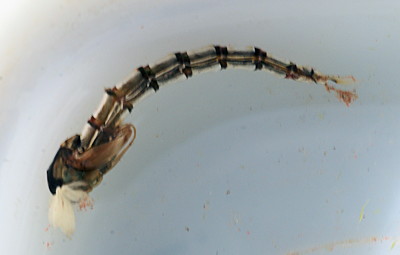 Capable of surviving in a diverse range of habitats and conditions chironomids are found in bogs, lakes, ponds, rivers, streams, salt water marshes even sewage treatment ponds. From the tropics to the Arctic chironomids are one hardy insect. Preferred aquatic environments feature soft stable bottoms and weeds, traits of slow moving stretches, spring creeks, tail waters, lakes and ponds. In western North America productive mud bottom lakes are home to a staggering number of species, many capable of attaining large sizes. Close to an inch in some instances, a definite contradiction to their midge moniker. Capable of surviving in a diverse range of habitats and conditions chironomids are found in bogs, lakes, ponds, rivers, streams, salt water marshes even sewage treatment ponds. From the tropics to the Arctic chironomids are one hardy insect. Preferred aquatic environments feature soft stable bottoms and weeds, traits of slow moving stretches, spring creeks, tail waters, lakes and ponds. In western North America productive mud bottom lakes are home to a staggering number of species, many capable of attaining large sizes. Close to an inch in some instances, a definite contradiction to their midge moniker.
Depending upon species and habitat chironomids are found in a wide range of sizes, from too small to imitate to the monster "bomber" chironomids of the west, larva are close to an inch in length. Rivers and streams often feature smaller sizes due in part to multiple generations. Species capable of more than one hatch cycle per season are often smaller as a result of less growing time between hatches. Multiple emergences are common in southern latitudes and warmer water temperatures. Conversely, some species feature one year cycles and are typically large. Pattern choices range from #24 to #16. Depending upon the region stillwater fly boxes feature larger sizes, #18 to #6 in some cases. Clear water lakes and ponds tend to feature smaller sizes while rich mud bottom algae type lakes are ideal habitat for larger species such as Tendipes. Chironomid larvae grow through 3 to 4 instars. Within species there is a downsizing between stages, a trait common to many insects. Larvae are larger than pupae which in turn are larger than adults, a key consideration when choosing patterns during an emergence. 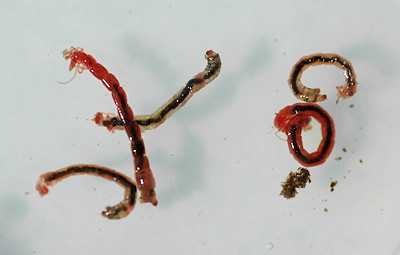 | | Bloodworms |
Slender and worm-like, chironomid larva have 9 body segments and short stubby pro-legs fore and aft. Successful larval patterns should be svelte and incorporate wire ribbing to suggest segmentation and weight the dressing, aiding presentation. Larval patterns should be presented near the bottom where naturals are most often found. Pupa possess more definitive features, bodies are slim tapered and segmented, adopting a distinct comma profile. The thorax is distinct and bulbous featuring wing pads that are a worth imitating. The legs and antenna trail beneath the thorax, on larger pupa patterns these can be suggested using a beard hackle. Perhaps the most prominent feature on the pupa are the stark white gills located on the front dorsal area of the thorax. These should be imitated. Favourite materials include white ostrich herl, Midge Gill, Antron, Polypropylene and Superwhite beads. Larger "bomber" pupa also feature less prominent caudal gills and are worthy of imitation. The critical key to as successful pupa pattern is maintaining a slim anorexic profile. Obese patterns should be avoided. 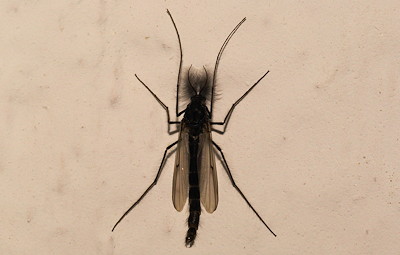 | | Adult Chironomid |
Adults closely resemble their pesky mosquito cousins. Thankfully chironomid females possess no piercing proboscis. A stroll through a mating swarm may result in an accidental swallowing but no bites! Adult chironomids have slender tapered bodies similar to the pupa no tails and a pair of wings that trail back over the body when at rest. The thorax area is humped and they often feature prominent eyes. Males are easily be identified by their plumose antenna is used to aid their search for a mate. Females on the other hand display fine difficult to see antenna.Chironomid coloration is as varied as the individual species and the environments in which they life. Coloration is also affected during the transitional phases of their life cycle. Chironomid larva can be found in white, green, olive, brown, red and maroon. Free living species in lakes are often olive or bright green while those species living in the bottom ooze lean toward red or maroon. The red or maroon color larva common to stillwaters have been nicknamed bloodworms due their distinct color. This coloration is due to these larval species ability to generate haemoglobin within their iron based blood system. Haemoglobin enables survival in anoxic conditions such as rotting debris along the bottom or when higher water temperatures reduce dissolved oxygen. Red or maroon larvae are common in productive algae type waters that can be less oxygenated than their clear water counterparts. Some species take on a banded red/green appearance as their haemoglobin intake increases or decreases. Banded larva are common on many productive lakes during the early fall as the dissolved oxygen content increases due to reduced water temperatures. 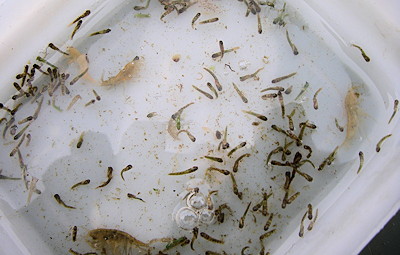 Pupae come in a myriad of colors including black, maroon, brown, tan, olive and various shades of green. Maroon is a versatile pattern color as depending upon the light conditions it can appear as black, brown and its parent color. Black is another ideal color choice and a black body red rib is a favoured color combination for many seasoned chironomid fly fishers. The trapped air and gases the pupa uses to aid the pupal ascent and final transformation to adult has a distinct bearing on the overall color scheme of the pupa. Inflated pupae radiate a distinct shine depending upon their progression through the pupa stage. Pre staging pupae early in the hatch tend to be subdued and as the level of trapped air and gases increases so does their radiance. Bright body materials such as Flashabou, Crystal Flash, Midge Flex, Frostbite and Midge Stretch Floss are preferred body choices. Bright ribbing materials such as gold, copper or silver wire should also be employed for flash and contrast. From personal observation, the sheen of the trapped air and gases varies further adding to the puzzle as the pupa color changes as it rises through the water column. Many species retain haemoglobin from the larval stage manifesting around the body segments and the tip of the abdomen in particular. Red butt pupae are common on many waters and pattern design should take this into account. Pupae come in a myriad of colors including black, maroon, brown, tan, olive and various shades of green. Maroon is a versatile pattern color as depending upon the light conditions it can appear as black, brown and its parent color. Black is another ideal color choice and a black body red rib is a favoured color combination for many seasoned chironomid fly fishers. The trapped air and gases the pupa uses to aid the pupal ascent and final transformation to adult has a distinct bearing on the overall color scheme of the pupa. Inflated pupae radiate a distinct shine depending upon their progression through the pupa stage. Pre staging pupae early in the hatch tend to be subdued and as the level of trapped air and gases increases so does their radiance. Bright body materials such as Flashabou, Crystal Flash, Midge Flex, Frostbite and Midge Stretch Floss are preferred body choices. Bright ribbing materials such as gold, copper or silver wire should also be employed for flash and contrast. From personal observation, the sheen of the trapped air and gases varies further adding to the puzzle as the pupa color changes as it rises through the water column. Many species retain haemoglobin from the larval stage manifesting around the body segments and the tip of the abdomen in particular. Red butt pupae are common on many waters and pattern design should take this into account.
Adult coloration varies little from the pupa, upon emergence however adult coloration tends to be brighter until their bodies harden. Trout preying on adults in selective situations can become color sensitive and brighter, recently emerged adults still unable to take flight until their bodies and wings harden are easy fare. Chironomid life cycles are as varied as the individual species and the environments in which they inhabit. The worm-like larva can be free living amongst bottom debris or aquatic vegetation. Other species construct tubes in the mud water interface along the bottom. A number of river and stream species construct cases similar to caddis. Larval populations can be dense, especially on productive stillwaters with square meter populations in the thousands. Depending upon the species larva can be herbivore or carnivore crawling about to feed. Feeble swimmers, exposed larva move through the water using a vigorous head to tail lashing motion taking rests in an outstretched posture. Slow paced retrieves coupled with pauses work best when imitating larva on stillwaters Free swimming larva are easy prey and trout feed upon them year long. During warm winter days river and stream anglers can do well dead drifting small Brassie patterns just above the bottom. Once the larva matures they either construct cases or transform into the pupa within the security of their burrows. Other larva are capable of transforming into the pupa within the boundaries of their larval skin. 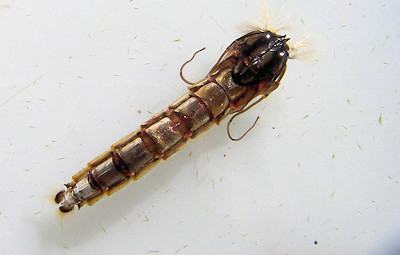 | | Pupa |
The pupal stage is synonymous with chironomid or midge fishing. Ascending pupae expose themselves in large quantities and trout take full advantage of this opportunity. Fly fishers should spend the majority of their time, at least 70% imitating the pupa. Recently transformed stillwater pupa often hover in clouds above the bottom 2-3 days before completing their trek to the surface. Perhaps a result of the time it takes to gather the air and gases needed to aid their adult transformation. It is common to find trout stuffed with pupa with little in the way of adults at the surface signifying an emergence is taking place. Pupa rise and wiggle slowly through the water column to the surface to completing their final transformation to adult, at the surface they suspend momentarily then adopt a horizontal posture. A split forms along the back of the thorax and the adult aided by the trapped air and gases crawls out in front of the now cast pupa shuck. Cast shucks retain the white gills at the head. Observant anglers look for these shucks as a hatch indicator. Most trout prefer to feed just above the bottom where it is efficient and safe. However, concentrations and surface conditions allow trout will follow migrating pupa upwards. As with larval presentations floating lines and long leaders with and without indicators are the preferred presentation methods. In deeper waters over 20 feet sinking lines can be used. Not all chironomids emerge successfully and there are many stillborns available. Opportunistic predators, trout target both stillborns and suspending pupa. Observe the rise form. Gentle sipping or porpoise rises are a sure sign that trout are targeting prey just beneath the surface. At this time try creeping or drifting small soft hackles through the foraging pod. Emergences can be localized and observing bird activity can provide clues to hatch location.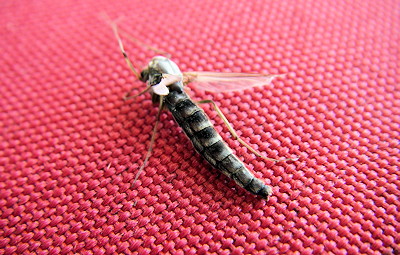 | | Emerged Chironomid |
Once emergence is complete adults fly off to shoreline areas. Most adults do not feed and this stage is short lived, just long enough to propagate the species. Males form large swarms resembling dust clouds along the margins. Large concentrations of adults are audible from a distance and create a high pitched buzzing sound. Hence their English nickname, "buzzers". Males release pheromones to attract a mate. Mating takes place in the air or on the ground. During low light conditions when the water is calm on stillwaters and the risk of avian predation is reduced egg laden females return to the water to deposit their eggs. Females skate across the surface speed boat style or dive below to lay their eggs. Skittering females draw trout to the surface providing anglers dry fly opportunities. Adults often form huge mats on the surface and on rivers and streams collecting in calms and back eddies. Trout move into these areas sipping adult clusters with slow deliberate rises. Patterns such as the Griffiths Gnat are good choices in these conditions. Many times it is difficult to tell if a trout has taken the fly. Get into the habit of using the fly line as site and lift the rod smoothly if a rise occurs near the fly. It is surprising how often the rise is to the fly that otherwise would have gone unnoticed. This tactic has paid dividends on numerous occasions. |



